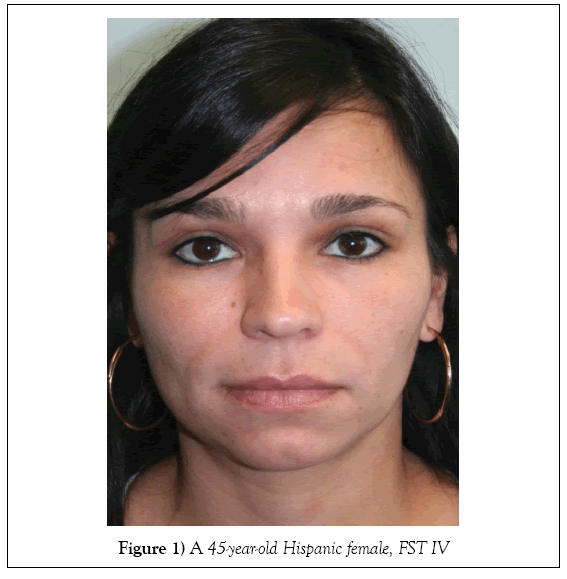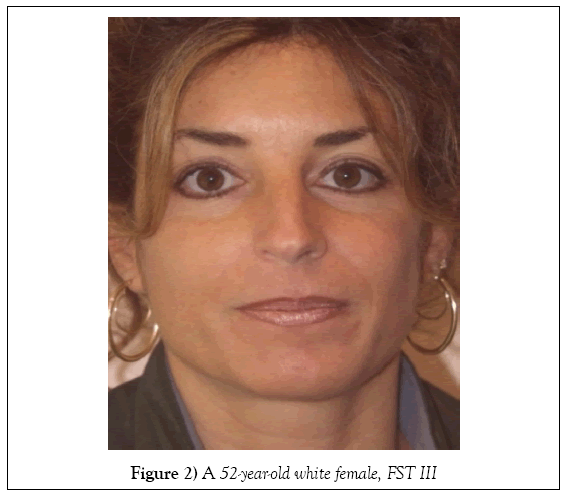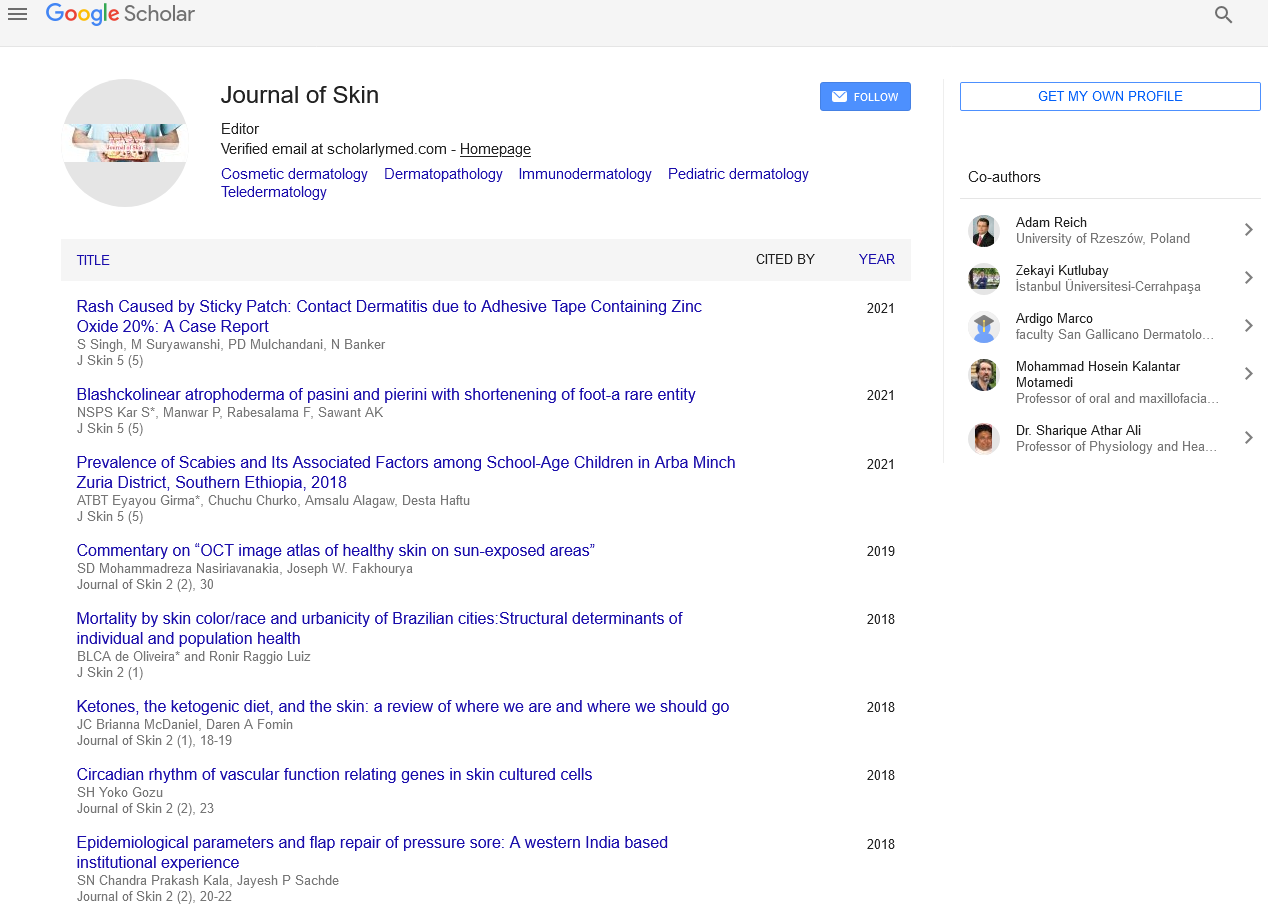Treatment based, multi-specialty skin classification system: Guidelines for assessing skin response to cosmetic treatments
Received: 13-Dec-2017 Accepted Date: Feb 07, 2018; Published: 15-Feb-2018
This open-access article is distributed under the terms of the Creative Commons Attribution Non-Commercial License (CC BY-NC) (http://creativecommons.org/licenses/by-nc/4.0/), which permits reuse, distribution and reproduction of the article, provided that the original work is properly cited and the reuse is restricted to noncommercial purposes. For commercial reuse, contact reprints@pulsus.com
Abstract
Fitzpatrick Skin Typing (FST) is the most utilized skin classification system and was described in 1975 by Thomas Fitzpatrick, MD. The classification types skin in relation to its sensitivity to ultraviolet radiation and the resultant risk of developing skin cancer. It is a tool familiar to dermatologists, plastic surgeons and all practitioners treating the skin with light-based technology and skin peels. The von Luschan scale was used to establish racial classifications of populations according to skin color; in contrast to the Fitzpatrick scale which was intended for the classification of the skin type of individuals to describe sun exposure. The primary use of the Fitzpatrick System today is in the ever-expanding and ubiquitous field of cosmetic skin treatments. These treatments are performed by a spectrum of operators ranging from specialist and non-specialist physicians to ancillary medical staff and spa employees with no formal medical training. Furthermore, medical lasers and other skin treatments such as Chemical Peels, Intense Pulse Light (IPL) and Light Emitting Diode (LED), are used in many different settings and for a multitude of therapeutic indications from hair removal to skin resurfacing. They all have, as a common denominator, the risk of injury to the skin with potential sequelae such as burns, scarring, hyper-pigmentation and hypo-pigmentation. In this paper, a new skin classification system is proposed in which patients fall into one of three groups
Keywords
Non-physician practitioners; Lase; IPL; Post-inflammatory; Hyperpigmentation.
Laser is an acronym for “Light Amplification by Stimulated Emission of Radiation.” The theory of stimulated emission was based on Einstein’s quantum theory of radiation [1-4]. The first laser was produced by Theodore H. Maiman in 1960 using ruby as a lasing medium [5]. Leon Goldman was the first to use Laser applications in medicine in 1962 [6]. Anderson and Parrish [7] described the theory of selective photo-thermolysis in 1983, thereby creating a new way of delivering laser energy whilst simultaneously sparing the effects on surrounding tissues. Threshold fluence and Thermal relaxation Time are critical concepts in understanding selective photothermolysis.
1 Threshold fluence (TF) of a tissue is energy per surface area, which if equaled or exceeded leads to the tissue destruction.
2 Thermal relaxation time (TRT) is defined as the time required by an object to cool down to 50% of the initial temperature achieved.
For tissue damage to occur, the laser wavelength is absorbed by the chromophore (melanin, hemoglobin, water or tattoo pigment) into the tissue target and not absorbed by the surrounding tissue. The pulse duration of the laser energy is less than or equal to the TRT of the target. If duration exceeds the TRT the energy is dissipated to surrounding tissues with ineffective results on the target chromophore. If energy delivery is within the TRT limits, the fluence reaching the target must equal or exceed the TF to cause tissue destruction. This endpoint is achieved by manipulating the wavelength, pulse duration, and fluence.
In the late 1990s and early 2000’s, the laser gold-standard for treatment of facial lines wrinkles, acne and scars, was the carbon dioxide (CO2) laser. The CO2 laser was a continuous beam laser which removed all the epidermis and a portion of the dermis. Downtime was approximately one week. Side-effects included pain, edema, persistent erythema, infections, post-inflammatory hyperpigmentation, and especially hypopigmentation which was seen as late as two years following the laser treatment. The erbium:yttrium-aluminumgarnet (Er:YAG) laser was introduced with a higher absorption coefficient for water and theoretically, less risk of similar adverse events as CO2 lasers. However, hypopigmentation with the Er:YAG lasers still occurred as well as other problems like those of the CO2 laser [8].
Fractional Thermolysis
The concept of Fractional Thermolysis (FT) was first described by Huzaira et al. in 2003 [9] and further elucidated by Manstein et al. [10]. FT was developed to enable laser surgeons to approximate clinical results of ablative lasers such as the CO2 laser, without the downtime and side effects. FT is the production of an injury pattern to the skin with normal skin in between columns of laser energy. These columns of thermal injury are called Micro Thermal Zones (MTZs). MTZs vary depending on the device. Some are nonablative dermal injuries, whilst, others create ablative changes in the skin, causing epidermal and dermal injury. Once injured, the skin begins a very rapid repair process. The repair mechanisms seen in FT occur through the transepidermal delivery of treated necrotic skin into the stratum corneum, which is exfoliated away [10]. The process in which necrotic material is incorporated into columns of debris to be sent to the epidermis, is known as microscopic epidermal necrotic debris (MEND). The rapid healing process is facilitated by surrounding untreated skin—a process unique to FT [10]. It has been suggested by Geronemus [11] and others to classify ablative FT lasers into “micro-ablative FT laser systems,” which include lasers that produce tissue damage to depth less than 750 microns, and “deep dermal ablative FT laser systems,” which include lasers that produce damage beyond 750 microns.
Skin Typing
The Fitzpatrick Skin Types (FST) were described in 1975 [1,12], The concept of sun-reactive “skin typing” was created for a specific need; to be able to classify persons with white skin to select the correct initial doses of ultraviolet A (UVA) (in joules/cubic centimeter) in the application of the treatment of psoriasis-oral methuselah photochemotherapy (PUVA) [10].
FST were based on responses to two questions:
1. How painful is your sunburn (i.e., intensity of erythema, edema, and discomfort) after 24 hours?”
2. How much tan will you develop in a week?”-
“there are two groups of the white population with clear-cut answers.
One group will reply: ‘I will have a painful burn at 24 hours and no tan at seven days.’ (This is sun-reactive skin type I). Phenotypically, these are fairskinned individuals with blue or hazel eyes, blond or red hair, and with skin that burns and peels easily, and their sunburn may last for several days. Some may, alas, also have dark hair and brown eyes.”
Another group will respond: “No burn at 24 hours and a good tan at seven days.” This group is called skin type IV.
There are, in addition, two subgroups of skin types I and IV. A subgroup of skin Type I will answer: “A painful burn at 24 hours (the same as skin type I response) and a light tan at seven days.” This group is skin type II. These are fair-skinned individuals with blond, red, or brown hair, green or hazel eyes, and skin that burns and peels easily. These individuals tan slightly only after repeated exposures. Also, a subgroup of skin type IV will respond: “A slightly tender burn at 24 hours and a moderate tan at seven days.” This is skin type III and is the largest group in the United States.
Later, in addition to white-skinned persons, brown- and black-skinned persons were included in the classification by Fitzpatrick [12] and Pathak et al. [13].
The many skin type classifications have been summarized by Roberts [14] (Table 1). Spectrophotometry is the most reliable way to assess the photoprotection afforded by melanin, but the costs of reflectance spectrophotometry may prohibit its routine clinical use.
| Skin Classification System | Date of Publication |
|---|---|
| Schulze | 1956 |
| Fitzpatrick Scale | 1975 |
| Pathak Scale | 1976 |
| Kawada Skin Classification System for Japanese Individuals | 1986 |
| Glogau Scale | 1994 |
| Lancer Ethnicity Scale | 1998 |
Goldman World Classification of Skin Type |
2002 |
| Willis and Earles Scale | 2005 |
| Taylor Hyperpigmentation Scale | 2006 |
| Baumann Skin Type Solution | 2006 |
| Roberts Hyper-Pigmentation Scale | 2006 |
| Roberts Scarring Scale | 2006 |
Table 1: Skin classification systems
Discussion
The Fitzpatrick System is the most common Skin Classification System in use today by most Laser manufacturers. Roberts recognized the inability of the Fitzpatrick Types I-VI to reflect the response to the three i’s, insult, injury and inflammation [15], particularly in response to laser treatments and surgery. Roberts proposed a two-part classification based on medical history, physical exam and ancestry with 6 levels of increasing propensity for pigmentation H0-H6 and 5 degrees of increasing scar response S0– S5 [14,15].
There is an inherent paradox in the Fitzpatrick system as it relates to laser, light-based treatments and other modalities of therapy such as skin peels which cause injury and inflammation of the skin. FST’s are classified according to the amount of UV radiation required to produce erythema or a melanogenic response. Therefore, the dose of UV radiation tolerated is proportional; to the skin type, i.e., the higher the skin type, VI versus I, the higher the dose of UV radiation tolerated. Whereas the paradoxical situation arises in the application of lasers where the dose of radiation tolerated is inversely proportional to the skin type number; FST I tolerating a higher dose than FST VI. This alone is a source of confusion in the therapeutic algorithm.
A complicating factor is that laser and other cosmetic skin treatments are performed by a spectrum of operators including specialist and non-specialist physicians, ancillary medical staff and spa employees, often with no medical or laser training or State Regulation [16]. These treatments are provided in many different clinical and non-clinical settings for a multitude of therapeutic indications from hair removal to skin resurfacing. They all have, as a common denominator, the risk of injury, insult and inflammation to the skin with potential sequelae such as hyperpigmentation, hypopigmentation and scarring. Furthermore, there is an increased risk of litigation associated with laser surgery by non-physician operators [17,18].
The Fitzpatrick System was initially described to classify white skin. It now encompasses Japanese (Asian), Indian and African skin types. Type IV is no longer white skin but the more ethnic Latin/Central/South American [19] (Figures 1 and 2). The threshold of energy settings of laser treatments is usually divided between Type III and Type IV. Not only can it be difficult to classify the difference between Type III and IV but it is further complicated by the fact that a Type III may react as a Type IV based on the patient ethnic ancestry [19]. Categorizing the patient into Class III rather than a Class IV FST can result in an inappropriately aggressive treatment. There is also the issue of variation in skin typing between different operators, whether they be physicians, patients or non-physicians. Even dermatologists are unreliable when it comes to assessing FST [20]. Eilers noted that the spectrophotometry measurements for FST III vs. IV and FST IV vs. V were statistically significantly different (P<0.001) for dermatologist - versus spectrophotometer determined FST measurements. In the United States, the most common skin type is FST III which is 48% of the total [21] (Figures 1 and 2).
Against this clinical and therapeutic background and in an effort to streamline and simplify the treatment algorithm, thereby avoiding mistakes in skin-typing, a new skin classification system is proposed in which patients fall into one of three Groups; A, B or C (Table 2).
| Skin Group | FST | Phenotype/Ethnicity |
|---|---|---|
| Group A | I-II | White skin with minimal hint of pigmentation (Germanic-Northern European/Scandinavian) |
| Group B (Treat as Group C) |
III-IV | Olive skin (Southern European, Mediterranean, Central Eastern European, Sephardic Jewish) |
| Group C | V-VI | Yellow, light brown and black skin (East and West Asian, African) |
Table 2: Author skin classification
t is important to note that patients in Group B are treated initially as Group C, with less aggressive treatment parameters, increasing thereafter to more aggressive settings, depending on the response.
In terms of the skin response to the three ‘i’s, the distinction is between patients with little or no risk of hyperpigmentation and / or keloid scarring and patients who are at risk of post-inflammatory hyperpigmentation and scarring after cosmetic skin treatments.
Conclusion
Attempting to ‘skin type’ patients according to the FST Classification is subject to operator error, is confusing and most importantly, can and does lead to mistakes in evaluation when patients fall into the no-man’s land between FST III and IV. The plethora of different classifications [15] is proof that to date, there is no simple clinical guide to treatment parameters. The Fitzpatrick System remains the default, created not for laser but to evaluate the effect of UV radiation in relation to erythema and tanning response. It has proved a useful guide as to the needs for sun protection, [21] effects of sun damage and the risks of melanoma and other skin cancers. However, in the era of ubiquitous laser treatments, in multiple clinical and non-clinical settings by medical and non-medical practitioners, it is not only unwieldly but also inaccurate in determining a specific treatment choice. Categorizing the patient into an incorrect FST can and often does result in an overly aggressive setting with resultant complications.
Treatment parameters can differ depending on whether a patient is placed into FST I-III versus FST IV-VI. Therefore, it is proposed that instead of having a treatment threshold between FST III and IV, that the threshold be set between FST II and III and FST IV and V, thereby creating three skin groups. Group A is equivalent to FST I-II and Group C FST V-VI and Group B, FST III-IV (Table 2). Any B patient is managed initially as a C.
Notwithstanding any of the above, it is incumbent upon the clinician, as always, to evaluate the patient carefully, considering the medical history, physical exam and ancestry as well as ruling out any pre-existing conditions, such as a history of herpes infection or current or past medications such as isotretinoin. If in doubt as to the correct skin type or response to treatment, one should choose either not to treat or to start with a lower setting or a test area, thereafter increasing the settings with subsequent treatments. Lastly, one should consider pretreating patients with a risk of hyperpigmentation.
Disclosure
The author declared no potential conflicts of interest with respect to the research, authorship and publication of this article.
REFERENCES
- Fitzpatrick TB. Soleil et peau. J Med Esthet. 1975;2:33-4.
- Von Luschan F. Beiträge zur Völkerkunde der Deutschen Schutzgebieten. Berlin: Deutsche Buchgemeinschaft. 1897.
- Von Luschan F, Rassen V, Sprachen: Anthropologische Betrachtungen. Berlin: Deutsche Buchgemeinschaft. 1927.
- Einstein A. Einstein A. Zur Quantentheorie der Strahlung. Physikalische Gesellschaft Zürich Miteilungen. 1916;18:47-62.
- Maiman T. Stimulated optical radiation in ruby masers. Nature I960;187:493-4.
- Goldman L. Pathology of the effect of the laser beam on the skin. Nature. 1963;197:912-4.
- Anderson RR, Parrish JA. Selective photothermolysis: Precise microsurgery by selective absorption of pulsed radiation. Science. 1983:220-524.
- Gold MH. Fractional technology: A review and clinical approaches. J Drugs Dermatol. 2007;6:849-52.
- Huzaira M, Lodhi A, Khatri KA. Erbium: YAG laser skin resurfacing: A Pakistani experience. J Cosmet Laser Ther. 2003;5:43-9
- Manstein D, Herron GS, Sink RKH, et al. Fractional photothermolysis: A new concept for cutaneous remodeling using microscopic patterns of thermal injury. Lasers Surg Med. 2004;34:426-38.
- Gold M. Update on fractional laser technology, J Clin Aesthet Dermatol. 2010;3:42-50.
- Fitzpatrick TB. The validity and practicality of sun reactive: Skin type I through VI. Arch Dermatol. 1988;124:869-71.
- Pathak MA, Jimbow K, Szabo G, et al. Sunlight and melanin pigmentation, in Smith KC (ed): Photochemical and Photobiological Reviews. New York, Plenum Press, USA. 1976:211-39.
- Roberts WE. The Roberts skin type classification system. J Drugs Dermatol. 2008:452-56
- Choudhry S, Kim N, Gillum J et al. State medical board regulation of minimally invasive cosmetic procedures. J Am Acad Dermatol. 2011;66:86-91.
- Jalian HR, Jalian CA, Avram MM et al. Increased risk of litigation associated with laser surgery by non-physician operators. JAMA Dermatol. 2014;150:407-11.
- Jalian HR, Jalian CA, Avram MM et al. Common causes of injury and legal action in laser surgery. JAMA Dermatol. 2013;149:188-93.
- Lancer HA. Lancer ethnicity scale (LES). Lasers Surg Med. 1998;22:9.
- Eilers S. Accuracy of self-report in assessing Fitzpatrick skin phototypes I through VI. JAMA Dermatology. 2013;149:1289-94
- Keiser E, Linos E, Kanzler M, et al. Reliability and prevalence of digital image skin types in the USA: Results from National Health and Nutrition Examination Survey 2003-2004. J Am Acad Dermatol. 2012;66:163-5.
- Sunscreen drug products for over-the-counter human drugs: Proposed safety, effective, and labeling conditions. Federal Register 1978;43:38206-7.







